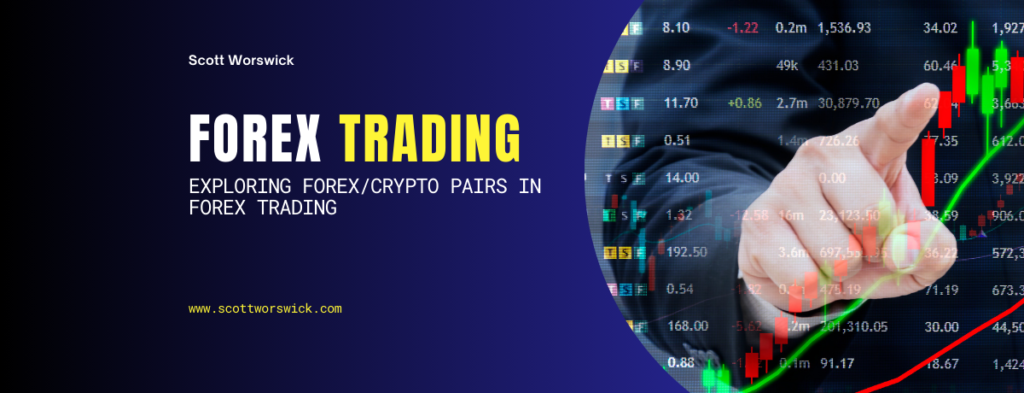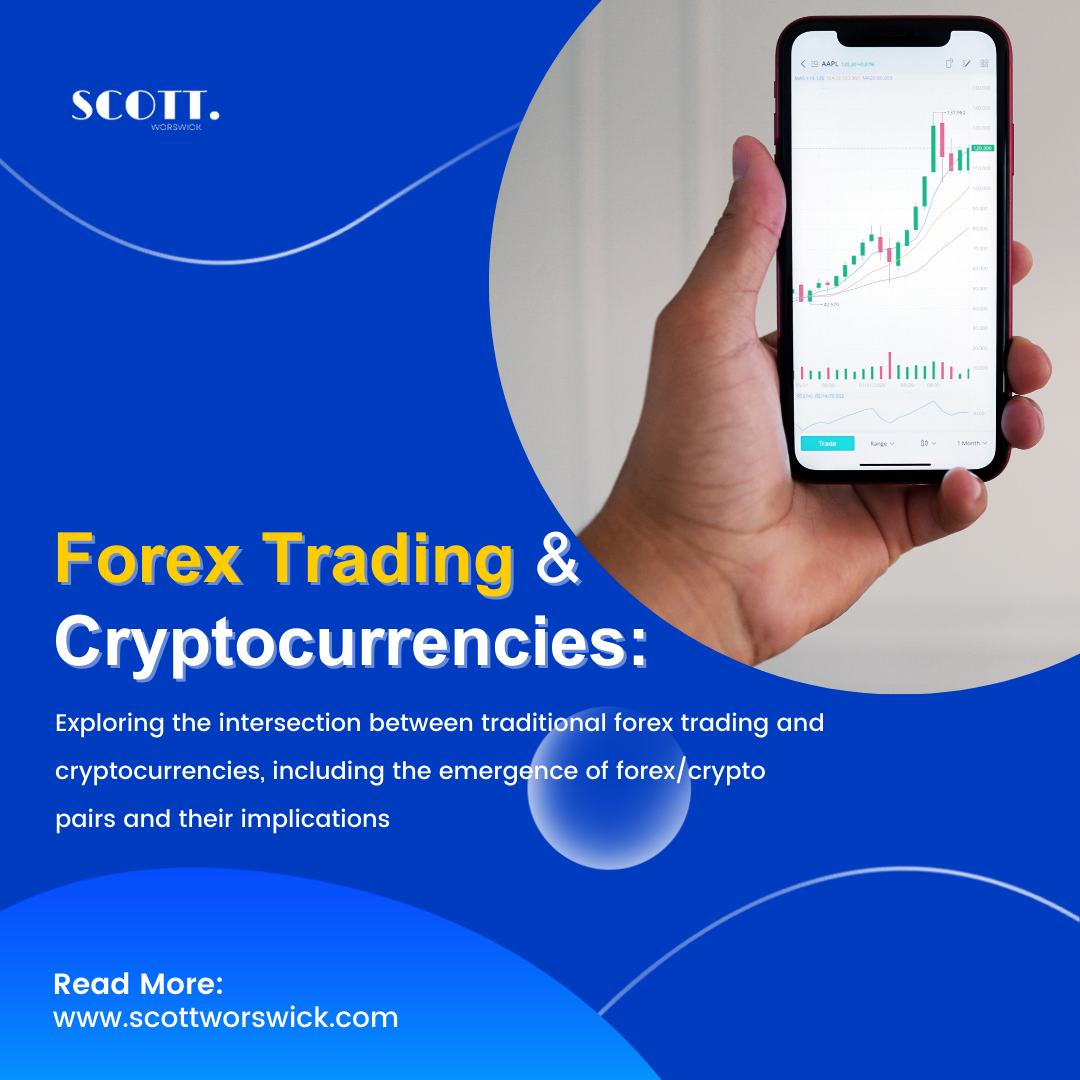In the realm of financial markets, the intersection between traditional forex trading and cryptocurrencies has sparked profound intrigue and speculation. As digital currencies like Bitcoin, Ethereum, and Litecoin continue to captivate the imagination of investors worldwide, their integration into the established forex landscape has blurred the lines between conventional and digital assets. This convergence heralds a new era of opportunity and complexity, as traders grapple with the implications of navigating both traditional forex markets and the burgeoning cryptocurrency sphere.
The emergence of forex/crypto pairs stands as a testament to the evolving dynamics of the financial world, offering traders unprecedented avenues for diversification and speculation. With pairs such as BTC/USD and ETH/EUR becoming increasingly prevalent on trading platforms, investors now have the ability to leverage their knowledge of traditional forex principles to engage with the volatile world of cryptocurrencies. Yet, this fusion of markets brings with it a host of challenges, as traders must contend with the unique characteristics and regulatory uncertainties inherent in the cryptocurrency space.
As traditional forex trading collides with the digital frontier of cryptocurrencies, the implications for market participants are manifold and far-reaching. While the integration of digital assets into the forex landscape offers new opportunities for profit and portfolio diversification, it also introduces heightened levels of risk and complexity. Traders must navigate the volatility of cryptocurrency markets while adhering to the principles of risk management and strategic decision-making that underpin traditional forex trading. In this intricate dance between tradition and innovation, mastering the intricacies of forex/crypto pairs is paramount for those seeking to thrive in this rapidly evolving financial ecosystem.
Table of Contents
1. Understanding the Convergence

The convergence between traditional forex trading and cryptocurrencies signifies a pivotal moment in the evolution of financial markets. At its core, this convergence represents the blending of established principles of currency exchange and trading with the disruptive potential of blockchain technology and digital assets. Unlike traditional fiat currencies, cryptocurrencies operate on decentralized networks, transcending geographical boundaries and intermediaries. This fundamental distinction introduces a new dimension of complexity to the forex landscape, as traders seek to navigate the intricacies of digital currencies alongside their traditional counterparts.
Within this convergence, the emergence of forex/crypto pairs serves as a tangible manifestation of the integration between traditional forex trading and cryptocurrencies. These pairs, denoted by symbols such as BTC/USD or ETH/EUR, allow traders to speculate on the exchange rates between cryptocurrencies and fiat currencies. By offering a bridge between the world of digital assets and traditional currencies, forex/crypto pairs enable investors to capitalize on the volatility and market dynamics inherent in both domains. This fusion of markets not only expands the scope of trading opportunities but also underscores the growing relevance of cryptocurrencies in the global financial ecosystem.
Yet, as the convergence between traditional forex trading and cryptocurrencies unfolds, it brings forth a host of challenges and considerations for market participants. The volatility of cryptocurrency markets, characterized by rapid price fluctuations and speculative fervor, contrasts starkly with the relatively stable and regulated environment of traditional forex trading. Consequently, traders must navigate this juxtaposition of market dynamics with prudence and discernment, balancing the potential for profit with the inherent risks associated with digital assets. Moreover, the regulatory landscape surrounding cryptocurrencies adds another layer of complexity, as regulatory scrutiny and legal frameworks continue to evolve in response to the proliferation of digital currencies.
In essence, the convergence between traditional forex trading and cryptocurrencies represents a paradigm shift in the way we perceive and engage with financial markets. As digital assets become increasingly intertwined with traditional currencies, the distinction between these realms begins to blur, giving rise to a new hybrid landscape of trading opportunities and challenges. By understanding the intricacies of this convergence and adapting their strategies accordingly, traders can position themselves to capitalize on the transformative potential of this evolving financial ecosystem.
2. Exploring Forex/Crypto Pairs in Forex Trading

Forex/crypto pairs have emerged as a dynamic bridge between traditional forex trading and the world of cryptocurrencies, offering traders a unique avenue to engage with both asset classes simultaneously. These pairs, denoted by symbols like BTC/USD or ETH/EUR, represent the exchange rates between cryptocurrencies and fiat currencies such as the US dollar or euro. By facilitating the direct trading of digital currencies within the framework of traditional forex markets, these pairs provide investors with opportunities to capitalize on the volatility and liquidity inherent in both realms.
The introduction of forex/crypto pairs has significantly expanded the scope of trading opportunities available to market participants, enabling them to diversify their portfolios and hedge against currency risks with greater flexibility. Unlike standalone cryptocurrency exchanges, where trading is often limited to digital assets, forex/crypto pairs allow traders to leverage their expertise in traditional forex trading to navigate the nuances of cryptocurrency markets. This convergence of markets not only fosters cross-pollination of trading strategies but also promotes a deeper integration of digital assets into the broader financial ecosystem.
However, exploring forex/crypto pairs also presents traders with unique challenges and considerations. The extreme volatility of cryptocurrency markets, coupled with their susceptibility to speculative sentiment and external factors, can amplify the risks associated with trading forex/crypto pairs. Moreover, the regulatory uncertainties surrounding cryptocurrencies add another layer of complexity, as traders must remain vigilant to changes in legal frameworks and compliance requirements. In navigating these complexities, traders must exercise caution and implement robust risk management strategies to mitigate potential losses while capitalizing on the opportunities afforded by forex/crypto pairs.
3. Navigating Market Dynamics
Understanding the intricacies of market dynamics is essential for traders venturing into the realm of forex/crypto pairs. While traditional forex trading operates within well-established frameworks and regulatory environments, the landscape of cryptocurrency markets is characterized by heightened volatility and rapid price fluctuations. This divergence in market dynamics necessitates a nuanced approach to trading forex/crypto pairs, one that incorporates elements of risk management, technical analysis, and an understanding of the unique factors influencing cryptocurrency prices.
The volatility of cryptocurrency markets presents both opportunities and challenges for traders navigating forex/crypto pairs. On one hand, the extreme price fluctuations inherent in cryptocurrencies can offer substantial profit potential for savvy traders who capitalize on short-term price movements. On the other hand, this volatility introduces increased risk exposure, as sharp price swings can result in significant losses if not managed effectively. Therefore, traders must employ disciplined risk management strategies, such as setting stop-loss orders and diversifying their portfolios, to mitigate the inherent risks associated with trading forex/crypto pairs.
Moreover, the interconnected nature of global financial markets means that external factors can exert a significant influence on the price movements of both traditional forex pairs and cryptocurrencies. Economic indicators, geopolitical events, and central bank policies can all impact currency valuations and market sentiment, transcending the boundaries between traditional and digital assets. Traders must remain vigilant to these external factors and stay informed about market developments to make informed trading decisions in the ever-evolving landscape of forex/crypto pairs.
In navigating the dynamic landscape of forex/crypto pairs, traders can leverage a range of technical and fundamental analysis tools to gain insights into market trends and price movements. Technical indicators, such as moving averages and stochastic oscillators, can help identify potential entry and exit points for trades, while fundamental analysis enables traders to assess the underlying factors driving cryptocurrency prices. By combining these analytical approaches with a thorough understanding of market dynamics, traders can enhance their ability to navigate the complexities of forex/crypto pairs and capitalize on the opportunities presented by this convergence of traditional and digital assets.
4. Implications for Traders and Investors
The convergence between traditional forex trading and cryptocurrencies carries profound implications for traders and investors across the financial landscape. One significant implication is the expansion of trading opportunities and the diversification of investment portfolios. With the emergence of forex/crypto pairs, traders now have access to a broader range of assets to trade, allowing for greater flexibility and risk management. By incorporating cryptocurrencies into their portfolios alongside traditional forex pairs, investors can hedge against currency risks and capitalize on the potential for profit in both markets.
However, along with expanded opportunities come heightened levels of risk and volatility. Cryptocurrency markets are notoriously volatile, with prices subject to rapid and unpredictable fluctuations driven by factors such as market sentiment, regulatory developments, and technological innovations. As such, traders engaging in forex/crypto pairs must exercise caution and implement robust risk management strategies to protect their capital from significant losses. Moreover, the lack of regulatory oversight and transparency in cryptocurrency markets adds an additional layer of complexity, requiring traders to conduct thorough due diligence and stay informed about market developments.
Another implication of the convergence between traditional forex trading and cryptocurrencies is the potential for technological innovation and disruption within the financial industry. Blockchain technology, the underlying infrastructure behind cryptocurrencies, has the potential to revolutionize various aspects of the financial ecosystem, including payment processing, remittances, and asset tokenization. By embracing this technological shift and exploring opportunities within the burgeoning field of digital assets, traders and investors can position themselves at the forefront of innovation and potentially reap substantial rewards in the long term. As the intersection between traditional forex trading and cryptocurrencies continues to evolve, those who adapt and capitalize on emerging trends stand to benefit from this transformative convergence.
5. Adapting to the New Frontier
As traditional forex trading collides with the burgeoning realm of cryptocurrencies, traders must adapt their strategies and approaches to thrive in this new frontier of financial markets. One crucial aspect of adaptation involves embracing technological innovations and leveraging advanced tools and platforms to navigate the complexities of forex/crypto pairs. By harnessing the power of algorithmic trading algorithms, advanced charting software, and automated trading systems, traders can gain a competitive edge in analyzing market trends and executing trades with precision and efficiency.
Furthermore, adapting to the new frontier entails cultivating a deep understanding of the unique characteristics and dynamics of cryptocurrency markets. Unlike traditional forex trading, which operates within established regulatory frameworks and centralized institutions, cryptocurrency markets are decentralized and subject to a myriad of factors such as market sentiment, technological advancements, and regulatory developments. Therefore, traders must stay informed about the latest trends and developments in the cryptocurrency space to make informed trading decisions and mitigate risks effectively.
In addition to technological prowess and market knowledge, adapting to the new frontier of forex/crypto pairs requires a mindset shift towards innovation and agility. Traders must be willing to embrace change and experiment with new strategies and approaches to capitalize on emerging opportunities and navigate market uncertainties. This may involve exploring alternative trading platforms, experimenting with different trading styles, or diversifying investment portfolios to include a mix of traditional forex pairs and cryptocurrencies. By remaining adaptable and open to new ideas, traders can position themselves to thrive in the rapidly evolving landscape of forex/crypto trading.
Ultimately, adapting to the new frontier of forex/crypto trading is a journey of continuous learning and adaptation. As the intersection between traditional forex trading and cryptocurrencies continues to evolve, traders must stay ahead of the curve by staying informed, embracing technological innovations, and cultivating a mindset of innovation and agility. By doing so, traders can not only navigate the complexities of forex/crypto pairs but also capitalize on the transformative potential of this convergence to achieve their financial goals in the digital era.
Conclusion
The intersection between traditional forex trading and cryptocurrencies represents a pivotal moment in the evolution of financial markets. The emergence of forex/crypto pairs has blurred the lines between conventional currency trading and the world of digital assets, offering traders unprecedented opportunities for diversification, speculation, and profit. However, this convergence also brings with it a host of challenges, including heightened volatility, regulatory uncertainties, and technological complexities, which traders must navigate with caution and diligence.
Despite these challenges, the integration of cryptocurrencies into the forex landscape underscores the growing relevance of digital assets in the global financial ecosystem. As blockchain technology continues to gain traction and cryptocurrencies become increasingly mainstream, the boundaries between traditional currencies and digital assets will continue to dissolve, reshaping the dynamics of forex trading and investment. By embracing this convergence and adapting their strategies to leverage the unique opportunities presented by forex/crypto pairs, traders can position themselves to thrive in this rapidly evolving landscape.
In the face of ongoing technological innovation and regulatory developments, one thing remains certain: the convergence between traditional forex trading and cryptocurrencies is here to stay. As traders and investors navigate this new frontier, they must remain adaptable, informed, and agile, continually refining their approaches to capitalize on emerging trends and opportunities. By doing so, they can harness the transformative potential of this convergence to achieve their financial objectives and stay ahead of the curve in the digital era of finance.





Pingback: The Role of Technology in Modern Forex Trading - Discuss the Impact of Technology on Forex Trading -